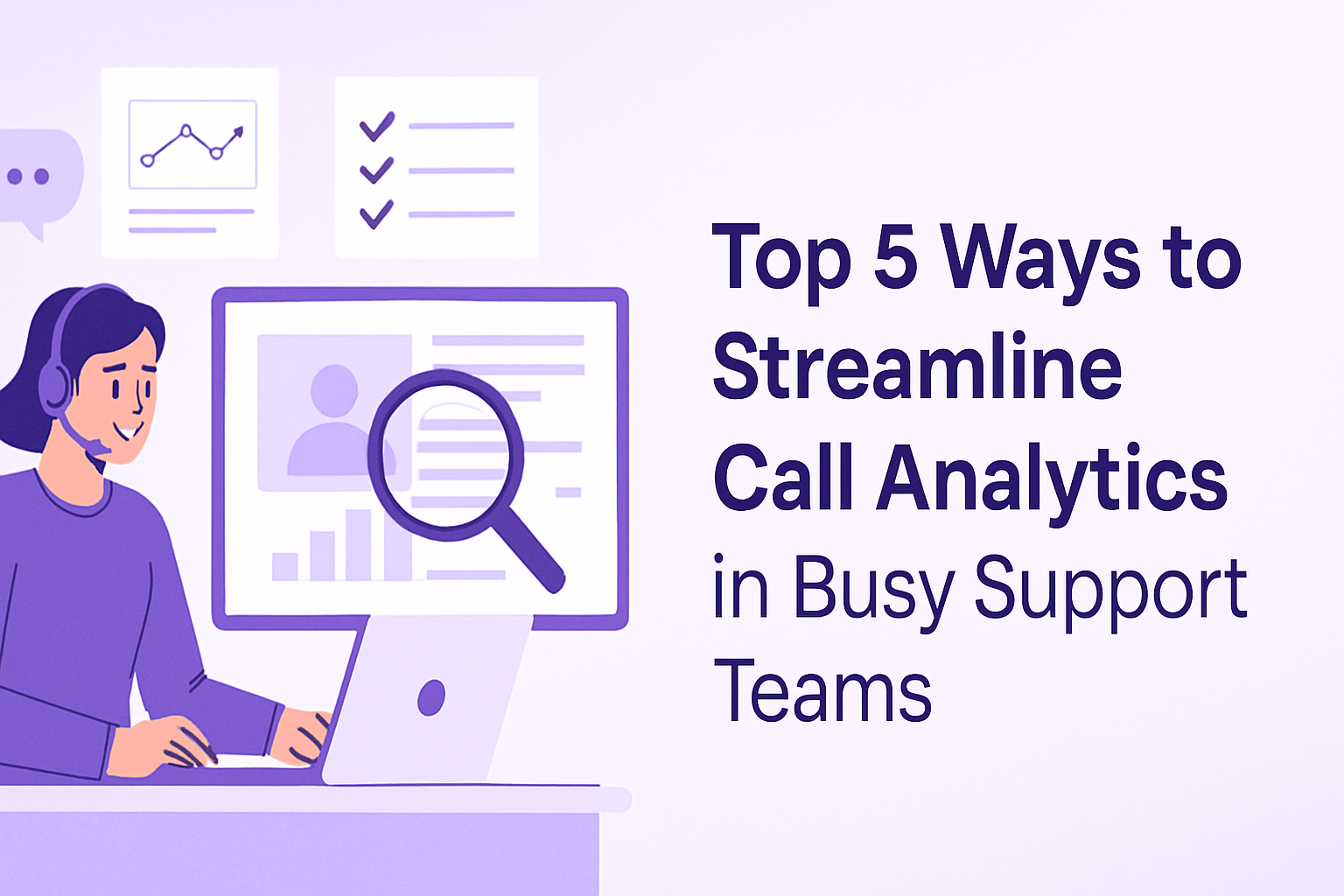Enhancing Agent Performance with Real-Time Call Analytics
-
Hello Insight
- 10 min read
Enhancing Agent Performance with Real-Time Call Analytics
Real-time call analytics has emerged as a crucial tool for businesses aiming to elevate the performance of their agents. By leveraging data from customer conversations, organizations can gain insights that not only enhance agent performance but also improve customer satisfaction and operational efficiency. This guide delves into how real-time call analytics can transform your business processes, offering a roadmap for implementation and outlining its strategic benefits.
The Role of Enhancing Agent Performance with Real-Time Call Analytics in Modern Business
In today's competitive market, B2B companies are increasingly relying on customer feedback to inform product development and go-to-market (GTM) strategies. Yet, the challenge remains: customer feedback is often siloed across various channels, making it difficult to analyze effectively. Real-time call analytics facilitates a shift from reactive responses to proactive strategies, automating the analysis of numerous calls to provide actionable insights.
This approach not only streamlines processes but also fosters alignment across teams, ensuring that everyone from sales to customer service is on the same page regarding customer needs and agent performance. To implement this successfully, access to integrated data sources and a commitment to continuous improvement are essential.
What is Enhancing Agent Performance with Real-Time Call Analytics?
Enhancing agent performance with real-time call analytics refers to the systematic analysis of customer interactions through call recordings and analytics software. This method focuses on evaluating agent performance against predefined criteria, enabling organizations to identify strengths and weaknesses in real time.
Unlike traditional methods, which often look back at historical data, real-time analytics provides immediate insights that help organizations adapt and respond swiftly. By focusing on current interactions, businesses can better understand customer sentiments and improve service delivery.
Core Capabilities:
- Performance Evaluation: Measure agent effectiveness based on real-time criteria.
- Customer Insights: Gather and segment data to understand customer needs.
- Training Enhancements: Use call analysis to identify coaching opportunities for agents.
- Operational Efficiency: Optimize workflows based on data-driven insights.
- Compliance Tracking: Ensure adherence to regulatory standards through monitored calls.
Strategic Value: By employing real-time call analytics, organizations can make informed decisions that enhance agent performance and customer experiences, driving overall business growth.
Why Are Consultant and Insight-Seeking Personnel Investing in Enhancing Agent Performance with Real-Time Call Analytics?
Context Setting: Companies are transitioning from outdated methods of managing customer interactions, which often rely on manual processes and subjective evaluations. This transformation is fueled by the need for more efficient, data-driven decision-making.
Key Drivers:
- Increased Demand for Efficiency: Traditional methods often fail to provide timely insights, leading to delayed responses to customer needs.
- Real-Time Feedback: The ability to analyze interactions as they happen allows organizations to make immediate improvements.
- Customization and Personalization: Real-time analytics enables more tailored interactions, improving customer satisfaction.
- Enhanced Training and Development: Analytics provide concrete examples for training, ensuring that agents are well-equipped to handle customer queries.
What Data Powers Enhancing Agent Performance with Real-Time Call Analytics?
Foundation Statement: A reliable real-time analytics system requires diverse data sources to build accurate models and insights.
Data Sources:
- Call Recordings: Capture actual customer-agent interactions.
- CRM Systems: Integrate data from platforms like Salesforce and HubSpot for holistic insights.
- Feedback Channels: Utilize data from surveys and customer interviews to inform performance metrics.
- Communication Tools: Leverage data from platforms like Slack and Gong for comprehensive analysis.
- Sentiment Analysis Tools: Analyze customer sentiments in real time to adapt service delivery.
Accuracy Benefit: A multi-modal approach enhances the accuracy of insights, allowing organizations to make informed decisions based on a complete view of customer interactions.
Key Components of a Real-Time Call Analytics Stack
Stack Overview: The effectiveness of real-time call analytics lies in its multi-layered components that work together to deliver insights.
Component Descriptions:
- Call Recording Software: Captures interactions for analysis and training.
- Data Integration Tool: Synchronizes data from various sources for comprehensive insights.
- Analytics Engine: Processes call data to identify trends and patterns.
- Reporting Dashboard: Visualizes insights for stakeholders to easily interpret data.
- Feedback Loop Mechanism: Allows for ongoing refinement based on performance metrics.
Quality Emphasis: The effectiveness of a call analytics system hinges not just on the data it uses, but on the quality and interpretability of that data.
Success Dependency: Organizations must ensure that input signals are accurate and reliable to achieve meaningful outcomes from their analytics efforts.
How Does Enhancing Agent Performance with Real-Time Call Analytics Work Step by Step?
Step 1: Data Collection
Gather data from diverse sources, including call recordings, CRM platforms, and customer feedback forms.
Step 2: Data Integration
Utilize integration tools to compile data into a centralized system, enabling a holistic view of agent performance.
Step 3: Data Analysis
Analyze the collected data to identify performance patterns and customer sentiments:
- Sentiment Patterns: Understand customer satisfaction levels.
- Performance Trends: Evaluate agent effectiveness over time.
- Common Issues: Identify recurring complaints or challenges.
Step 4: Performance Evaluation
Assess agent performance against predefined criteria, offering a score that reflects their effectiveness.
Step 5: Real-Time Feedback
Deliver immediate feedback to agents based on performance metrics, facilitating prompt improvements.
Step 6: Reporting and Recommendations
Generate actionable reports that highlight strengths and areas for improvement, providing specific examples for coaching.
- Example Output 1: A detailed performance report for individual agents.
- Example Output 2: Insights on customer satisfaction trends over the last month.
- Example Output 3: Recommendations for training based on identified weaknesses.
Where Can Consultant and Insight-Seeking Personnel Apply Enhancing Agent Performance with Real-Time Call Analytics?
Use Case 1: Performance Scoring
- Prediction Method: Analyze call data to score agent performance.
- Recommended Action: Implement targeted training for low-scoring agents.
Use Case 2: Customer Interaction Analysis
- Analysis Approach: Evaluate customer calls to identify satisfaction levels.
- Follow-Up Action: Schedule additional training sessions for agents handling dissatisfied customers.
Use Case 3: Coaching Opportunities Identification
- Identification Method: Review call transcripts for common pitfalls.
- Proactive Scheduling: Implement regular coaching sessions based on identified needs.
Use Case 4: Efficiency Optimization
- Forecasting Approach: Analyze call volumes to predict peak times.
- Optimization Action: Adjust staffing levels based on predicted call traffic.
What Tools Can You Use for Enhancing Agent Performance with Real-Time Call Analytics?
When considering tools for real-time call analytics, look for platforms that offer comprehensive capabilities to enhance agent performance.
Comparison Table:
| Feature | Insight7 | Traditional Alternative |
|---|---|---|
| Call Recording | Yes | Limited |
| Real-Time Analytics | Yes | No |
| Customizable Criteria | Yes | No |
| Multi-Source Integration | Yes | Limited |
| Reporting Capabilities | Advanced | Basic |
Common Pitfalls in Enhancing Agent Performance with Real-Time Call Analytics Implementation
Context Warning: Organizations often face challenges when implementing real-time analytics due to a variety of factors.
Major Pitfalls:
- Lack of Data Integration: Failing to unify data sources can lead to incomplete insights.
- Resistance to Change: Stakeholders may be hesitant to adopt new technologies.
- Overlooking Training Needs: Without adequate training for agents, the benefits of analytics may not be realized.
- Neglecting Regular Reviews: Failing to continuously monitor and adjust metrics can lead to outdated insights.
Success Foundation: By addressing these pitfalls and focusing on a strategic implementation plan, organizations can maximize the benefits of real-time call analytics.
How Do You Get Started with Insight7?
Step 1: Integration Capability
Ensure that Insight7 can seamlessly integrate with your existing CRM and communication tools.
Step 2: Data Synchronization
Set up data synchronization to consolidate all relevant customer interaction data.
Step 3: Configuration Options
Customize the evaluation criteria based on your specific business needs and objectives.
Step 4: Historical Data Training
Utilize historical call data to train the system and refine analytics capabilities.
Step 5: Customization for Stakeholders
Adjust settings to cater to different teams, ensuring relevant insights for each function.
Step 6: Continuous Optimization
Implement a process for ongoing review and optimization of analytics to stay aligned with evolving business needs.
What Is The Best Enhancing Agent Performance with Real-Time Call Analytics Setup?
ROI Optimization: To maximize the return on investment, organizations should adopt best practices that ensure effective implementation.
Best Practices:
- Diverse Data Sources: Ensure a wide range of data inputs for comprehensive insights.
- Stakeholder Involvement: Engage various teams to define criteria and expectations.
- Historical Data Utilization: Use past data to inform future performance metrics.
- Regular Review Cadence: Schedule consistent evaluations of metrics and processes.
- Automation Integration: Automate data collection and reporting where possible.
Building a Enhancing Agent Performance with Real-Time Call Analytics Strategy That Scales
Creating a scalable strategy requires cross-functional alignment and a clear understanding of goals across teams. Different departments must collaborate to define the metrics that matter most, ensuring that the data utilized for decision-making is diverse and relevant. Implementing prioritization and automated feedback mechanisms will help maintain efficiency and effectiveness as your organization grows.
Enhancing Agent Performance with Real-Time Call Analytics Benchmarks and Success Metrics
Evaluation Framework: Establishing clear benchmarks is vital for measuring the impact of real-time call analytics.
Core Metrics:
- Call Handling Time (measures efficiency in managing calls)
- Customer Satisfaction Scores (assesses the quality of service)
- First Call Resolution Rate (indicates effectiveness in solving issues)
- Agent Performance Score (reflects individual agent effectiveness)
- Training Effectiveness (measures improvement post-training sessions)
Universal Principle: The primary rule across all implementations is that value is derived from making better decisions and taking more informed actions.
Frequently Asked Questions
Q: What is real-time call analytics?
A: Real-time call analytics involves the immediate analysis of customer-agent interactions to provide actionable insights for improving performance and customer satisfaction.
Q: How does this differ from traditional methods?
A: Traditional methods often analyze historical data, while real-time analytics focuses on current interactions, allowing for swift response and adaptation.
Q: What platforms are compatible with this approach?
A: Many CRM and communication platforms, like Salesforce and HubSpot, can integrate with real-time call analytics tools.
Q: What data is required for effective analysis?
A: Ideal data sources include call recordings, CRM data, and customer feedback collected from various channels.
Q: How long does implementation typically take?
A: Implementation speed varies but can often be completed within a few weeks, depending on the complexity of integration.
Q: What security measures are in place?
A: Most analytics platforms comply with industry standards such as SOC 2, GDPR, and HIPAA to ensure data security and privacy.






